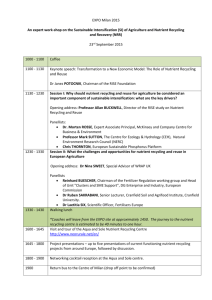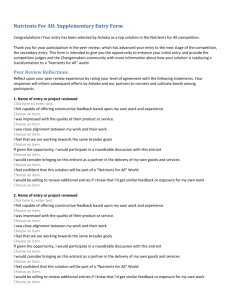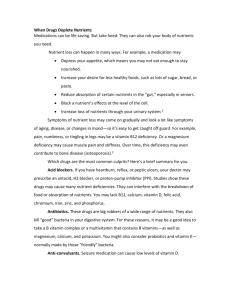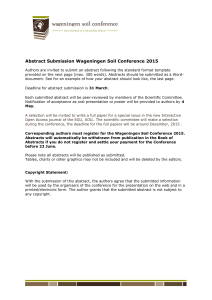Group 1 - EurEau
advertisement
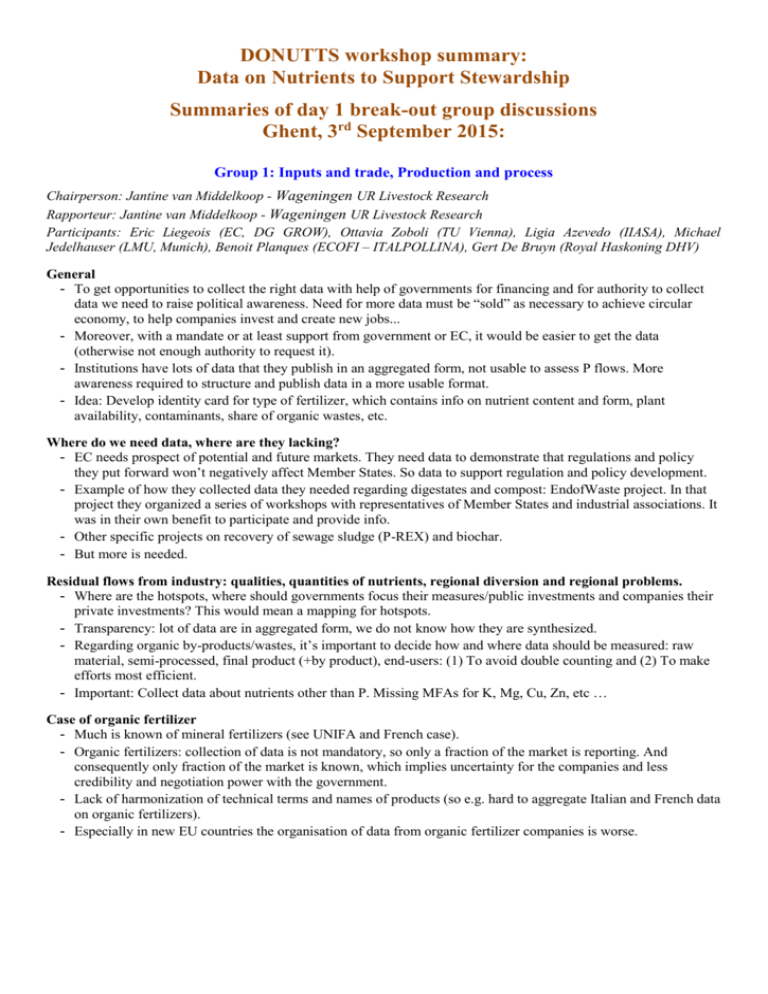
DONUTTS workshop summary: Data on Nutrients to Support Stewardship Summaries of day 1 break-out group discussions Ghent, 3rd September 2015: Group 1: Inputs and trade, Production and process Chairperson: Jantine van Middelkoop - Wageningen UR Livestock Research Rapporteur: Jantine van Middelkoop - Wageningen UR Livestock Research Participants: Eric Liegeois (EC, DG GROW), Ottavia Zoboli (TU Vienna), Ligia Azevedo (IIASA), Michael Jedelhauser (LMU, Munich), Benoit Planques (ECOFI – ITALPOLLINA), Gert De Bruyn (Royal Haskoning DHV) General - To get opportunities to collect the right data with help of governments for financing and for authority to collect data we need to raise political awareness. Need for more data must be “sold” as necessary to achieve circular economy, to help companies invest and create new jobs... - Moreover, with a mandate or at least support from government or EC, it would be easier to get the data (otherwise not enough authority to request it). - Institutions have lots of data that they publish in an aggregated form, not usable to assess P flows. More awareness required to structure and publish data in a more usable format. - Idea: Develop identity card for type of fertilizer, which contains info on nutrient content and form, plant availability, contaminants, share of organic wastes, etc. Where do we need data, where are they lacking? - EC needs prospect of potential and future markets. They need data to demonstrate that regulations and policy they put forward won’t negatively affect Member States. So data to support regulation and policy development. - Example of how they collected data they needed regarding digestates and compost: EndofWaste project. In that project they organized a series of workshops with representatives of Member States and industrial associations. It was in their own benefit to participate and provide info. - Other specific projects on recovery of sewage sludge (P-REX) and biochar. - But more is needed. Residual flows from industry: qualities, quantities of nutrients, regional diversion and regional problems. - Where are the hotspots, where should governments focus their measures/public investments and companies their private investments? This would mean a mapping for hotspots. - Transparency: lot of data are in aggregated form, we do not know how they are synthesized. - Regarding organic by-products/wastes, it’s important to decide how and where data should be measured: raw material, semi-processed, final product (+by product), end-users: (1) To avoid double counting and (2) To make efforts most efficient. - Important: Collect data about nutrients other than P. Missing MFAs for K, Mg, Cu, Zn, etc … Case of organic fertilizer - Much is known of mineral fertilizers (see UNIFA and French case). - Organic fertilizers: collection of data is not mandatory, so only a fraction of the market is reporting. And consequently only fraction of the market is known, which implies uncertainty for the companies and less credibility and negotiation power with the government. - Lack of harmonization of technical terms and names of products (so e.g. hard to aggregate Italian and French data on organic fertilizers). - Especially in new EU countries the organisation of data from organic fertilizer companies is worse. Group 2: “Agricultural nutrient uses and losses” breakout group summary Chairperson: Kersti Linderholm, Silver Mountain Environmental Engineering, Sweden Rapporteur: Chris Thornton, ESPP Participants: Gerard Velthof (Alterra, Wageningen UR), Susanne Klages (Thünen Institute of Rural Studies), Lies de Clercq (Ghent University), Sonia Lenders (Departement Landbouw en Visserij – AMS), Ulf Raesfeld (BauhausUniversität Weimar) General - Always specify unit to avoid confusion (P, PO4, P2O5, …) and specify dry matter or water content - Plant availability of phosphorus in different fertiliser products - disagreement in group around plant usefulness of different forms of P and how plant availability should be measured - EU Fertiliser Regulation update is expected to “decide” on this issue, so we did not further discuss - Form of nutrient is important in data (not just quantity), depending on possible uses/processes - in products - in wastes (e.g. iron and aluminium content of ash are relevant for feasibility of P-recovery, with current technologies) - in runoff (e.g. particulate P vs. orthophosphate) Why do we need data on nutrients? - Farmers need data, need to carry out nutrient balances (data on inputs and data on yields, emissions, offtakes) - to reduce fertiliser input costs - to implement BEMP, BAT … - nutrient balances or efficiencies may be required by sustainability/quality label systems of upstream (supermarkets, food industry),e.g. Field to Market requires nutrient management plan (tbc) - EU Directive implementation, input to policy decision - Industry market and investment decision What additional data is needed? - Soils, run-off, nitrogen fixation … - Data on crop residues / agricultural by-products: quantities, spatial distribution, nutrient content - Link between “Legacy P” (soil P accumulation) and risk of run-off to surface waters (eutrophication) - Much data is modelled: e.g. run-off, emissions, soil P accumulation … What data do we have? - Example of Sweden comprehensive data base of nutrient levels in all animal feed products on market - Much ‘local’ farmer data exists, is increasing with regulation (e.g. cross compliance), with quality labels and with precision farming: nutrient balances, fertiliser use data, soil analysis To do? - Collate existing scientific reports and data sources: requires time to ensure up-to-date inventory of available data and to assess how it can be transposed - Identify existing Member States reporting to Brussels and other European Commission studies on other industries/policies from which useful nutrient data can maybe be derived (e.g. bio-energy, food/diet …) - In what existing routine sampling could nutrient monitoring be possibly added - Open dialogue with food processing industry and food industry concerning what data they have, what data would be relevant to their sustainability management - Farmers and farmers’ organisation: develop dialogue concerning nutrient data and “big data” possibilities Group 3: Waste and Wastewater Chairperson: Christian Kabbe (Berlin Centre of Competence for Water) Rapporteur: Fabian Kraus (Berlin Centre of Competence for Water) Participants: Cynthia Carliell-Marquet (University of Birmingham), Wim Vanden Auweele (European Compost Network), Oliver Krüger (BAM Federal Institute for Material Research and Testing), Rob de Ruiter (EcoPhos), Elisabeth Nadeu (Rise Foundation), Carl Dewaele (NuReSys), Sofía Grau González (Depuractión de Aguas del Mediterráno) Why do we need data on nutrients? - Many data are currently collected because of limit value in the effluent of WWTP; not because of the potential for recovery and recycling. From that perspective we have to redefine the data collection-system. - The data can be used to support the change to a circular economy, to change our policy and support industry as one motor which will perform circular economy. Sound data are the foundation for investments by industry. Which data do we need? - At least C, N, P, (Fe, Al): Loads, Concentrations, Location (in feasible regional scale, e.g. agglomeration areas), Supply security (temporally issues like seasons). - For C, N, P: total and fractionized species (dissolved; form; organic bounded; precipitated) in the WWTP after different treatment steps as temporally limited Monitoring-Program for about 10 selected WWTP in Europe. It may be helpful, to a) cross-check this data and b) see similarities and differences by the design of the sewage system. - Detailed knowledge of these issues helps to increase recovery rate and energy efficiency of the system and try to establish optimized biological sewage systems. - For bio-waste, digestate and manure a better data quality is available than for nutrient contents in sewage sludge, since the influence of local infrastructure is limited. Seasonal ranges have a high effect. The most data on manure are available on manure because of the nitrates-directive. What data are currently missing? - Data enables technology development (strategically data; nutrient species and matrix elements) - Data on products (quality data; contaminants) - Data on macroscopic regional view (for industry and decision makers; loads and concentrations of nutrients; matrix elements) Which solutions do we suggest? - A measurable target for circular economy of nutrients (e.g. 50 % independency on P in 2050; N?) will push the collection of data, to find the „lowest hanging fruits” and support the transition towards nutrient recycling. Who should collect more data? - The Bottom-Up approach, but data transmission from bottom up is difficult, without a loss in quality. A matrix of raw data helps for better understanding. Statistics often mix data up; so the “lowest hanging fruits” cannot be identified in the statistics. By support of IT and data that are already available, we have to transfer them, make them comparable and exchange them. Group 4 Nutrient Balances and Indicators Chairperson: Frank de Ruijter (Plant Research International – Wagneningen UR) Rapporteur: Kimo van Dijk (Wageningen University) Participants: Koen van Keer (YARA), Vincent Delveaux (DG Growth), Geertrui Louwagie (European Environment Agency), Anne Miek Cremer (Dutch CBS, previously Eurostat), Erik Meers (Ghent University) Most important conclusions: - Indicators are one of the final uses of data, and data enhancement should focus on that goal - Decreasing trend in the last years in data gathering, because of reduced financial means - Industry is also interested in data, it gives also a better indication for business cases and provide arguments for loans from banks necessary to implement innovation - Voluntary industrial data systems would be very nice, but what is the quality and who checks the data and makes it readily available for research and policy - Fertilizer industry needs hard data about the quality, quantity and location of secondary nutrients, in that sense there is interest in better data systems - Distinguish between targets, indicators and labels - The development of indicators is a general societal trend, and can be policy driven or industry driven. Some industry is pro-active in using indicators, such as certain companies within the food sector - Regulation can be a driver of change by enforcement (e.g. around WWTP) or by incentivising (e.g. around carbon credits). - Will regulation be enforced or will it be on voluntary basis? Probably it has to be a mix. - Better data and monitoring in the last decades made environmental legislation successful in reducing the impact of humans, companies and society - We can better work with a ‘pulling carrot’ than a ‘pushing stick’, innovative frontrunners should get a reward, for example paid in ETS carbon credits which is already an existing system in place (although not working completely well). - Renewable energy directive provides a double incentive to both governments and companies with double accounting in case waste is properly recycled - Fertilizer industry is mostly seen as the primary potential future user of secondary nutrients, but this industry is only the start of the P chain, other sectors can take in P in their processes such as industry in feed and food P additives and chemistry - Recycling is the solution, but society should also work on a reduction of the P input and maybe even the turnover in systems and processes - Besides reuse and recovery of bio-nutrients from residues/wastes, recycling by mixing needs clear and reliable data and knowledge to combine different flows smart and safe - Quality aspects are plant and process specific, and thus very diverse to be measured all for all flows. Among many others, there can be a focus on TOC (total organic carbon), chlorine, aluminium, iron, water content - Mass spectrometers can be used to measure the whole periodic table in flows in society, but presently with significant costs. - Near infrared measurement is a nice innovation with much lower costs, but it has a high uncertainty (1 kg per ton deviation), good for macro nutrients but not for micronutrients - Definitions of waste flows are not the same among countries and companies, main categories should be determined to make quality assurance and trading simpler - Topology can be based on industry quality assurance systems, which already exist and is common language - Nutrient concentrations have similar importance as mass flows, and consequently should be monitored, if possible over time, including the water content - Choosing an indicator also depends on the audience and final goals, and we have to keep in mind it is relative, very suitable for comparison over time or between countries and systems - Recycling is not new, recycling industries such as the glass, paper and iron recycling industries exist for decades and must be used as a source of knowledge and data for the recycling of bio-nutrients Advantages of (bio)nutrient data systems and developing them further: - Quantity identification of flows (e.g. critical mass, security of delivery) - Quality aspects (e.g. concentrations, form of compounds, contaminants, etc.) - Overview of spatial location and availability of nutrients (e.g. mapping nutrient hotspots) - Identification of competition for similar flows - Basis for policy development - Requirement for monitoring to check on impact and strategy - Necessary to redefine and optimize systems, plants and processes - Enhance the knowledge and brings together demand and supply side - Scenario analysis over time including dynamic modelling for impact analyses - Linking flows and technologies and further development innovations to enhance nutrient recycling - Product development and innovation (e.g. fertilizer products) - Optimization of transport cost and other environmental footprints
